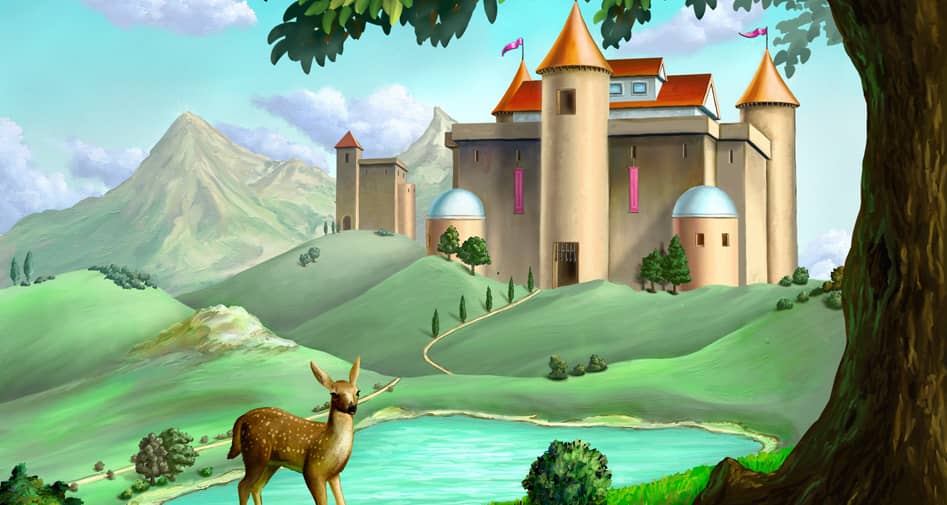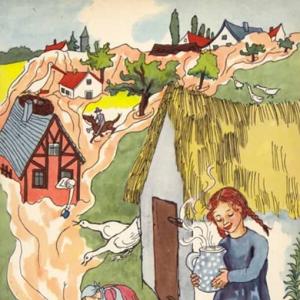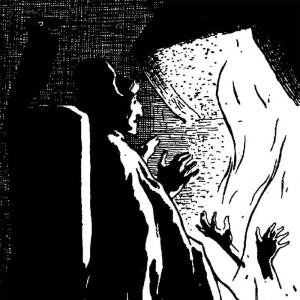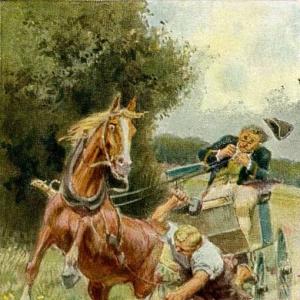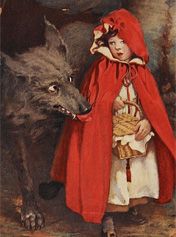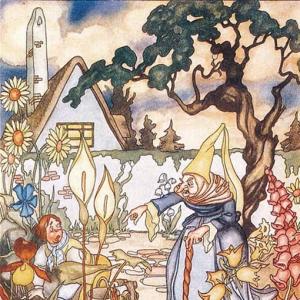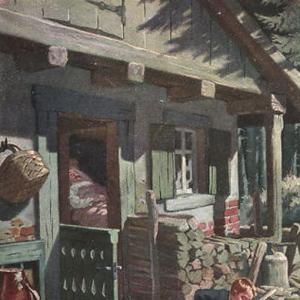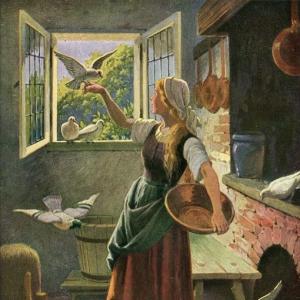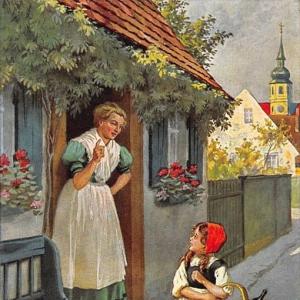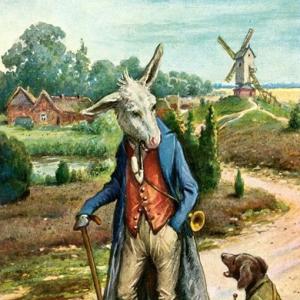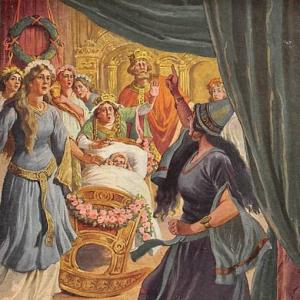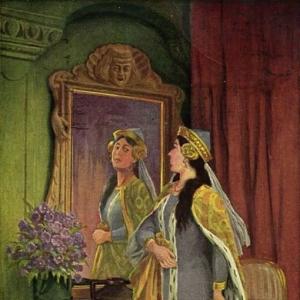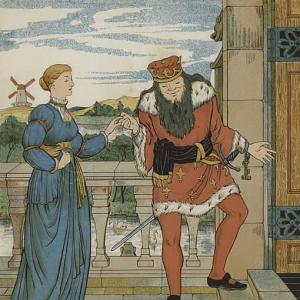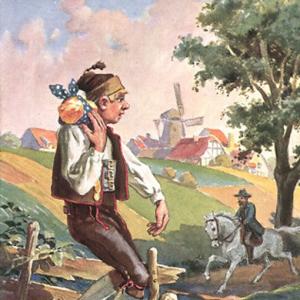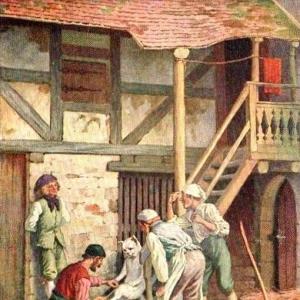Reading time for children: 4 min
In a large town there was an old woman who sat in the evening alone in her room thinking how she had lost first her husband, then both her children, then one by one all her relations, and at length, that very day, her last friend, and now she was quite alone and desolate. She was very sad at heart, and heaviest of all her losses to her was that of her sons; and in her pain she blamed God for it.
She was still sitting lost in thought, when all at once she heard the bells ringing for early prayer. She was surprised that she had thus in her sorrow watched through the whole night, and lighted her lantern and went to church. It was already lighted up when she arrived, but not as it usually was with wax candles, but with a dim light. It was also crowded already with people, and all the seats were filled; and when the old woman got to her usual place it also was not empty, but the whole bench was entirely full.
And when she looked at the people, they were none other than her dead relations who were sitting there in their old-fashioned garments, but with pale faces. They neither spoke nor sang; but a soft humming and whispering was heard all over the church. Then an aunt of hers stood up, stepped forward, and said to the poor old woman, „Look there beside the altar, and thou wilt see thy sons.“ The old woman looked there, and saw her two children, one hanging on the gallows, the other bound to the wheel.
Then said the aunt, „Behold, so would it have been with them if they had lived, and if the good God had not taken them to himself when they were innocent children.“ The old woman went trembling home, and on her knees thanked God for having dealt with her more kindly than she had been able to understand, and on the third day she lay down and died.
Grimm. It is a Japanese folktale that was adapted and tran
 Learn languages. Double-Tap on one word.Learn languages in context with Childstories.org and Deepl.com.
Learn languages. Double-Tap on one word.Learn languages in context with Childstories.org and Deepl.com.Backgrounds to fairy tale „The aged mother“
„The Aged Mother“ is a story adapted by the Brothers Grimm from a Japanese folktale. The Brothers Grimm, Jacob and Wilhelm, were German authors and scholars who lived in the late 18th and early 19th centuries. They are best known for their collection of fairy tales, which they gathered from oral and written sources, aiming to preserve and share the rich folkloric traditions of their homeland and Europe.
The original Japanese folktale, also known as „The Story of the Aged Mother“ or „Ubakawa,“ is a poignant story about a mother’s love and sacrifice. It is set during a time when the ruler of the land orders all elderly people to be abandoned in the mountains due to scarcity of resources. A young farmer, unable to abandon his mother, hides her in his home, but ultimately decides to carry her up the mountain as the ruler’s men are getting suspicious. Along the way, the aged mother leaves a trail of twigs to help her son find his way back. When the ruler faces a crisis, it is the wisdom of the aged mother that saves the day, leading to a change in the ruler’s decree.
The Brothers Grimm’s adaptation, while sharing some core themes such as the love and bond between a mother and her children, focuses more on the elderly woman’s grief and her realization of divine wisdom. The story emphasizes the importance of faith, understanding, and gratitude in the face of loss and adversity.
Interpretations to fairy tale „The aged mother“
„The Aged Mother“ is a powerful story that conveys several important themes and interpretations:
Trust in Divine Wisdom: The old woman initially blames God for her losses, unable to understand why He would take her sons away from her. However, after witnessing the grim fate her sons would have faced, she comes to realize that God’s wisdom and plan might not always be immediately clear, but it is ultimately for the best.
The Nature of Grief and Loss: The story portrays the old woman’s deep grief and loneliness, illustrating the universal experience of losing loved ones. As the woman mourns, she focuses on her own pain, failing to see the bigger picture until it is revealed to her.
The Transience of Life: The old woman’s story highlights the fleeting nature of human existence, as she outlives her family, friends, and loved ones. This theme is a reminder to cherish the time we have with those we care about and to make the most of our lives.
Family and Ancestral Connections: The presence of the old woman’s deceased relatives in the church emphasizes the bonds that continue to exist between the living and the dead. This theme suggests that even in death, our loved ones continue to watch over and guide us.
Forgiveness and Gratitude: Initially, the old woman harbors resentment towards God for her losses. However, after gaining new insight, she is able to forgive and express gratitude for His actions. This theme underscores the importance of forgiveness and gratitude in our lives, even when faced with adversity.
In summary, „The Aged Mother“ is a thought-provoking tale that encourages readers to trust in divine wisdom, acknowledge the transient nature of life, cherish family connections, and embrace forgiveness and gratitude in the face of hardship.
Summary of the plot
In „The Aged Mother,“ a Brothers Grimm fairy tale adapted from a Japanese folktale, an elderly woman mourns the loss of her family members, including her husband, children, and relatives. Left completely alone after the death of her last friend, she finds herself especially grieving the loss of her sons and questioning God’s actions.
One night, as she is lost in her sorrow, she hears the bells ringing for early morning prayer. Surprised that she has been awake all night, she lights her lantern and heads to church. Upon arriving, she finds the church dimly lit and full of people. To her astonishment, she sees that her dead relatives are occupying the seats, dressed in old-fashioned clothes and with pale faces. They neither speak nor sing, but a soft humming and whispering fills the church.
Her aunt approaches and directs her to look beside the altar, where she sees her two sons – one hanging from the gallows and the other bound to a wheel. Her aunt explains that this would have been the fate of her sons had they lived and not been taken by God when they were innocent children. Trembling, the old woman returns home, grateful for God’s mercy and understanding His wisdom in sparing her sons from such a fate. Three days later, she peacefully passes away.
Informations for scientific analysis
Fairy tale statistics | Value |
|---|---|
| Number | KHM 208 |
| Aarne-Thompson-Uther-Index | ATU Typ 934C |
| Translations | DE, EN |
| Readability Index by Björnsson | 37.7 |
| Flesch-Reading-Ease Index | 75.6 |
| Flesch–Kincaid Grade-Level | 9 |
| Gunning Fog Index | 11.9 |
| Coleman–Liau Index | 8 |
| SMOG Index | 9.6 |
| Automated Readability Index | 10.2 |
| Character Count | 1.847 |
| Letter Count | 1.428 |
| Sentence Count | 14 |
| Word Count | 353 |
| Average Words per Sentence | 25,21 |
| Words with more than 6 letters | 44 |
| Percentage of long words | 12.5% |
| Number of Syllables | 441 |
| Average Syllables per Word | 1,25 |
| Words with three Syllables | 17 |
| Percentage Words with three Syllables | 4.8% |
